Side Kick: Kicking leg training. Not for the height, but for injury prevention.
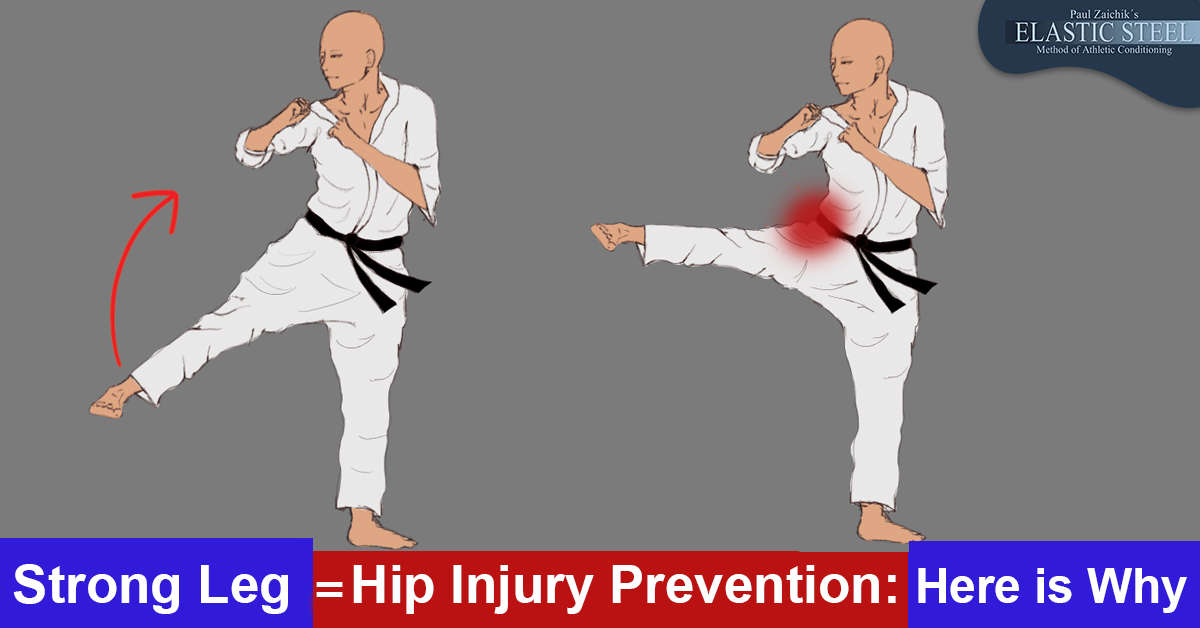
What's the deal with the Kicking leg? Why is it so important to work on it?
One of the questions that I often get is:
"Paul, you're saying that the kicking leg is not very important for the height of a sidekick, or for the height of a roundhouse kick or hook kick for that matter. Then why do you have a complete program focusing on the kicking leg?"
While it is true that the height of all three sideline kicks, the side kick, the hook and the roundhouse kick depends on the supporting leg. When it comes to the kicking leg, as many of the people that have been watching ElasticSteel videos and reading ElasticSteel articles, understand that it abducts to about 45 degrees. Any more than that and you need the flexibility of the supporting leg. And that is exactly the point.
"Paul, you're saying that the kicking leg is not very important for the height of a sidekick, or for the height of a roundhouse kick or hook kick for that matter. Then why do you have a complete program focusing on the kicking leg?"
While it is true that the height of all three sideline kicks, the side kick, the hook and the roundhouse kick depends on the supporting leg. When it comes to the kicking leg, as many of the people that have been watching ElasticSteel videos and reading ElasticSteel articles, understand that it abducts to about 45 degrees. Any more than that and you need the flexibility of the supporting leg. And that is exactly the point.
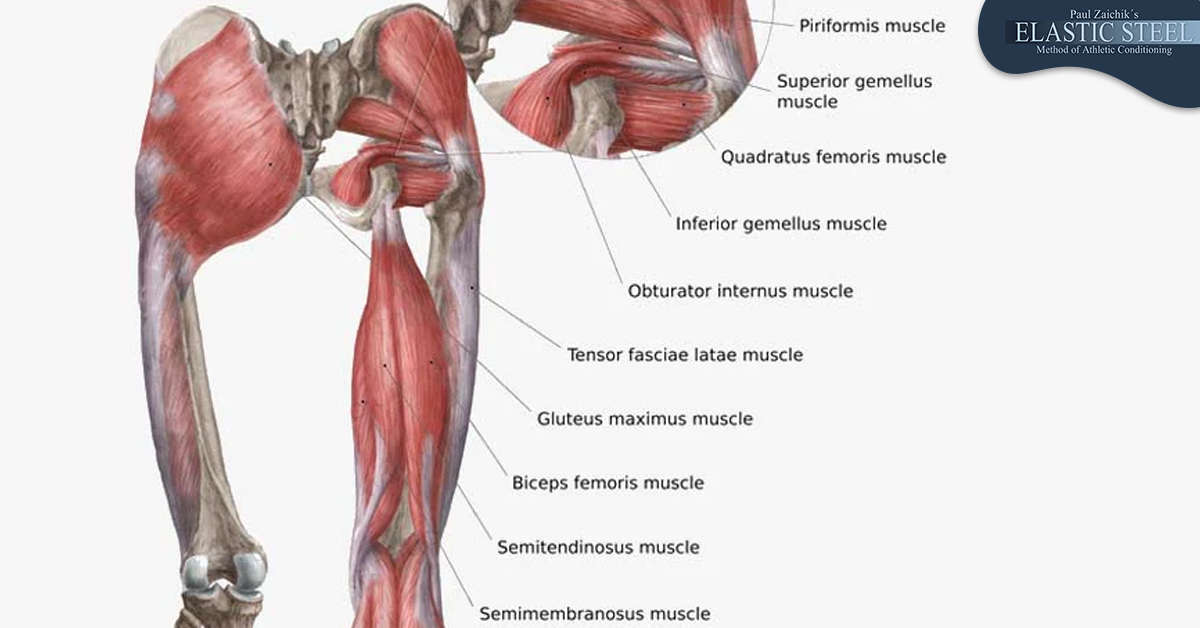
Having the strength in the abductors of the kicking leg is how you prevent injury of the hip.
Having the strength in the abductors of the kicking leg is how you prevent injury of the hip. I cannot tell you how many people over the last approximately 20 years have written to me, having practiced all kinds of martial arts styles and have hip injuries.
Many people cannot even kick anymore, at least on one side, sometimes on both sides, and some people have resorted to surgeries. Because of a very, very
specific thing. The weakness of the abductors of the kicking leg.
Now, the muscles that are your abductors (the ones that pull your leg up and out to the side) are very important here. If your abductors are weak, they cannot control the leg. If your abductors are strong, you can raise the leg with control to the point where you are not jamming your joint. That's a very specific type of strength. It's a short range strength.
Many people cannot even kick anymore, at least on one side, sometimes on both sides, and some people have resorted to surgeries. Because of a very, very
specific thing. The weakness of the abductors of the kicking leg.
Now, the muscles that are your abductors (the ones that pull your leg up and out to the side) are very important here. If your abductors are weak, they cannot control the leg. If your abductors are strong, you can raise the leg with control to the point where you are not jamming your joint. That's a very specific type of strength. It's a short range strength.
Short range strength is not natural strength that people have. It has to be developed.
Short range strength is not natural strength that people have. It has to be developed. Let me explain it this way. If you cannot bring your leg up with control into a sidekick position, you will throw your leg up. In other words, you will use the strength where you have it, to compensate for the lack of strength where you don't.
And this lack of strength is in short range. So you will contract the muscle in normal range so that it would get somehow into the short range. Well, this is how you injure your hip.
This is how the mechanism of injuring someone's hip looks like when you throw sideline kicks: side kick, roundhouse kick and hook kick. With side kick being the most prone to that injury. But you can absolutely do the same with the roundhouse kick and a hook kick.
If you have weak abductors, its just going to take longer for you to get that injury with the roundhouse kick and a hook kick, then with the side kick. But it's still going to happen, unfortunately. So developing the kicking leg is the protection.
Don't confuse the protection with an ability to kick higher. Having strong muscles in your kicking leg in short ranges of your abduction will prevent an injury. It's not going to allow you to kick higher. If you want to kick higher, you have to develop the supporting leg. And that's why we have a separate program for the supporting leg.
And this lack of strength is in short range. So you will contract the muscle in normal range so that it would get somehow into the short range. Well, this is how you injure your hip.
This is how the mechanism of injuring someone's hip looks like when you throw sideline kicks: side kick, roundhouse kick and hook kick. With side kick being the most prone to that injury. But you can absolutely do the same with the roundhouse kick and a hook kick.
If you have weak abductors, its just going to take longer for you to get that injury with the roundhouse kick and a hook kick, then with the side kick. But it's still going to happen, unfortunately. So developing the kicking leg is the protection.
Don't confuse the protection with an ability to kick higher. Having strong muscles in your kicking leg in short ranges of your abduction will prevent an injury. It's not going to allow you to kick higher. If you want to kick higher, you have to develop the supporting leg. And that's why we have a separate program for the supporting leg.
Side Kick Height Supporting Leg Online Training Program
Kicking height of the side line kicks, depends on the flexibility of the supporting leg or standing leg. In order to throw a high kick, the kicking side of the pelvis must tilt up. If the pelvic does not tilt, the kicking hip abduct no more than 45 degrees.
This means that a kick will be thrown no higher than the knee. Even a kick to the groin requires 90 degrees abduction (abduction is lifting of the leg to the side).
This means that a kick will be thrown no higher than the knee. Even a kick to the groin requires 90 degrees abduction (abduction is lifting of the leg to the side).
So the pelvic position must change. Once the pelvis moves, the flexibility of the supporting leg comes into play. Of course not just flexibility, but also strength.
In this training program you will learn:
- Very short and straight to the point method of developing kicking height:
- 3 carefully selected Zaichik Stretching Technique exercises for flexibility (formerly called Kinesiological Stretching Techniques). Each one takes just a few seconds to complete per round. Together these techniques develop super fast flexibility.
- Combined with extended length conditioning strength technique, the body quickly develops the range of motion for high kicks.
Beautiful, effective, strong and very importantly, safe, Sidekick is not just about the height of the kick.
There could be two people. Both of them cannot kick high. Both of them don't have developed supporting leg, but one has developed kicking leg. And that person has control and they're not jamming their joint every time they thrown a kick. And another person has no control and they're jamming their joint. Because again, all they're doing is accelerating their leg up without any control in the ranges where they have strengths. So that they can compensate for the ranges where they lack strength in the hip muscles.
Beautiful, effective, strong and very importantly, safe, Sidekick is not just about the height of the kick. If it was just about the height of the kick and nothing else, we would focus just on the supporting leg. And you know, in the ElasticSteel Kick Mastery System we have a program for the torso. You can read about it here for
the kicking leg and for the supporting leg.
So, if all you want to do is reach very high with your kick, you don't need the flexibility of your kicking leg or your torso, just the supporting leg. Actually, there are a lot of kickers with their body dropping to the floor. All they are doing is they develop good flexibility in their supporting leg. They don't have control of the kicking leg, but their kick is high, and I don't think that's what most people want.
That's definitely not what I wanted not when I was a kid and not now. Sure, I was happy to be able to kick somebody in the head. But as I began to understand more and more, I realized that it's more than just, somehow my foot reaching somebody's head, and me feeling good that I'm able to do that.
Beautiful, effective, strong and very importantly, safe, Sidekick is not just about the height of the kick. If it was just about the height of the kick and nothing else, we would focus just on the supporting leg. And you know, in the ElasticSteel Kick Mastery System we have a program for the torso. You can read about it here for
the kicking leg and for the supporting leg.
So, if all you want to do is reach very high with your kick, you don't need the flexibility of your kicking leg or your torso, just the supporting leg. Actually, there are a lot of kickers with their body dropping to the floor. All they are doing is they develop good flexibility in their supporting leg. They don't have control of the kicking leg, but their kick is high, and I don't think that's what most people want.
That's definitely not what I wanted not when I was a kid and not now. Sure, I was happy to be able to kick somebody in the head. But as I began to understand more and more, I realized that it's more than just, somehow my foot reaching somebody's head, and me feeling good that I'm able to do that.

Developing the kicking leg has many benefits, one is control.
Of course, developing the kicking leg has many other benefits. One is control. Being able to kick someone precisely where you want to kick them. Not a general area somewhere between the sternum and the belly button, but an exact area. Not somewhere on a head, but precisely the chin, the jaw, the temple with full control.
Sidekick is the most difficult kick to control. Front kick, Roundhouse kick and hook kick are easier. Sidekick is the most difficult one. So if you want to have a pinpoint accuracy in your sidekick, well, you need a very well developed kicking leg.
Kicking leg also helps a lot with the power of the kick. If your adductors are weak your leg will continue to fall down. As the kick makes contact with the target there is a tendency for the leg to basically use the target to prevent it from falling down, if the abductors are weak. And you could see that often when when people throw the kick into the target, into an opponent, a bag or a pad. In other words, there's a tendency for the leg to kind of fall off before it gets pulled into the chamber, as opposed to shooting (if we're talking about sidekick) out and back without having that fall off.
Sidekick is the most difficult kick to control. Front kick, Roundhouse kick and hook kick are easier. Sidekick is the most difficult one. So if you want to have a pinpoint accuracy in your sidekick, well, you need a very well developed kicking leg.
Kicking leg also helps a lot with the power of the kick. If your adductors are weak your leg will continue to fall down. As the kick makes contact with the target there is a tendency for the leg to basically use the target to prevent it from falling down, if the abductors are weak. And you could see that often when when people throw the kick into the target, into an opponent, a bag or a pad. In other words, there's a tendency for the leg to kind of fall off before it gets pulled into the chamber, as opposed to shooting (if we're talking about sidekick) out and back without having that fall off.
If you have weak abductors you lose power!
Now, from the sparring point of view, if you're throwing a jab or cross or a straight punch, whichever you call it. If the arm falls down before you pull it back, of course, that exposes you.
It doesn't happen quite with the sidekick. Although if you rely on your chamber for protection, sometimes if you use a high chamber, you don't want that fall off to happen after the kick.
But, in most cases, it's not your protection that's a problem. It's just that if you have weak abductors you lose the power. Because the line of force of the kick changes, it's linear, and then it's no longer linear once the contact is made with the target.
It may still look linear because a person has his foot in the target and its not falling because the target is holding it up. But, the force is lost because the abductors on the supporting leg are weak. These muscles are not the main power muscles behind the kick, but they keep the trajectory proper so that the force goes where it needs to go.
So this article gives you some ideas of the importance of the supporting leg training, especially in short ranges, and how it will improve your kick. If you're interested developing your supporting leg please click here for more info.
It doesn't happen quite with the sidekick. Although if you rely on your chamber for protection, sometimes if you use a high chamber, you don't want that fall off to happen after the kick.
But, in most cases, it's not your protection that's a problem. It's just that if you have weak abductors you lose the power. Because the line of force of the kick changes, it's linear, and then it's no longer linear once the contact is made with the target.
It may still look linear because a person has his foot in the target and its not falling because the target is holding it up. But, the force is lost because the abductors on the supporting leg are weak. These muscles are not the main power muscles behind the kick, but they keep the trajectory proper so that the force goes where it needs to go.
So this article gives you some ideas of the importance of the supporting leg training, especially in short ranges, and how it will improve your kick. If you're interested developing your supporting leg please click here for more info.
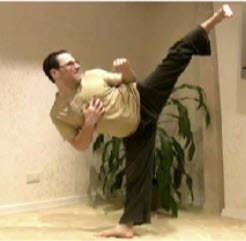
About the Author:
Paul Zaichik is an Exercise Science Expert, author of multitude of books, and the creator of Zaichik Stretching Technique (formely known as Kinesiological Stretching Technique). His speciality is flexibility training as well as body weight conditioning. His innovative method is designed to have maximum carry over into specific athletic techniques. Paul is the author of books and DVD’s on the topic of flexibility, martial arts and bodyweight training. Over the years, Paul Zaichik has worked with a variety of individuals including athletes, entertainers, and military personnel. His ElasticSteel Method of Athletic Conditioning programs, EasyFlexibility Programs and Zaichik Stretching Techniques are used world wide by both professional and amateurs with great success.
YOU MAY ALSO BE INTERESTED IN
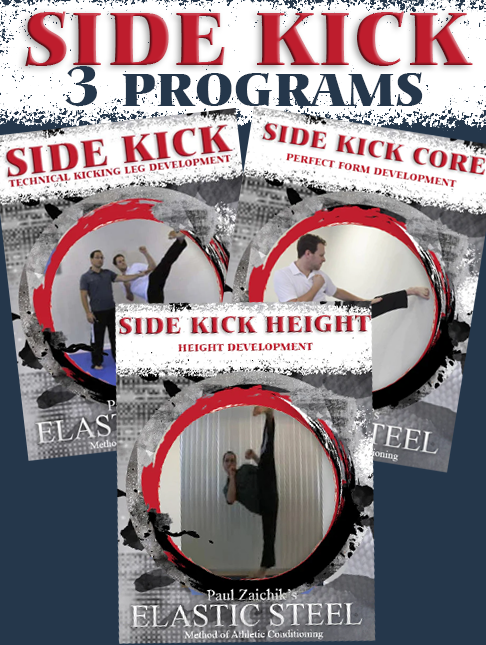
3 Program
Side Kick Combo
Side Kick Combo
This combo includes:
- Technical Kicking Leg Development
- Core Flexibility & Strength Development
- Height Development

7 Program
Side Kick Combo
Side Kick Combo
This combo includes:
- Technical Kicking Leg Development
- Core Flexibility & Strength Development
- Height Development
- Speed Development
- Precision & Accuracy Development
- Power Development
- Flying Side Kick
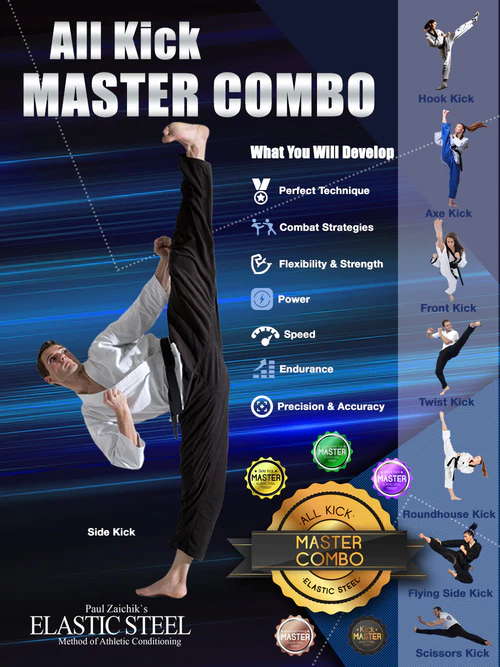
20 Program
All Kick Master Combo
+ 5 Gifts!
All Kick Master Combo
+ 5 Gifts!
This combo includes:
Side Kick:
- Technical Kicking Leg Development
- Core Flexibility & Strength Development
- Height Development
- Speed Development
- Precision & Accuracy Development
- Power Development
- Neutralizing Opponents Defense and Guard Penetration Set Ups
Roundhouse and Hook Kicks:
- Roundhouse Kick: Technical Kicking Leg Development
- Roundhouse Kick: Speed Development
- Roundhouse Kick: Power Development
- Hook Kick: Power Development
Front Kick:
- Front Kick and Front Line Kicks: Technical Kicking Leg Development
- Front Kick: Speed Development
- Push Front Kick: Power Development
- Axe Kick: Power Development
- Ball of the Foot: Point of Impact
Advanced Kicks:
- Scorpion Kick: Perfect form Development
- Flying Side Kick: Technique and Jumping Height Development
- Flying Split Scissors Kick, Two Direction Kick
- Twist Kick Technical Kicking Leg Development
- Twist Kick Follow Along Routine
+ 5 GIFTS!


Leave a comment